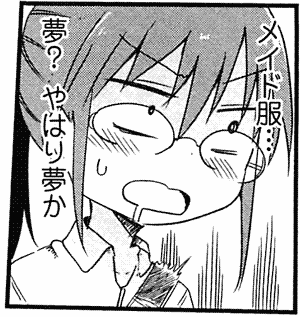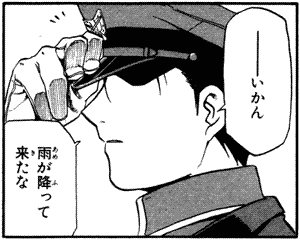This happens because most of the time you need an explicit "it" in English, you can simply omit "it" and leave "it" implicit in Japanese.
Manga: Kobayashi-san Chi no Meidoragon 小林さんちのメイドラゴン (Chapter 2, トールと出会い)
- Context: Kobayashi 小林 sees a dragon girl in maid clothes.
- meido fuku...
メイド服・・・
Maid clothes... - yume? yahari yume ka?
夢?やはり夢か?
[Is it a] dream? As I thought, [is it a] dream?
But let me explain more about each use of "it" in English and what's done in Japanese instead.
Dummy "It"
Let's start with the dummy "it," as "it" illustrates better the differences between English and Japanese grammar.In case you didn't know this, a dummy "it" in English happens when the English grammar syntax requires a subject, but you don't have one. That is, you have a verb, an action, and English be like: "oh, you got an action? Someone MUST be doing that action then!" So you must write it like this:
- Subject verb.
For example:
- I came.
- I saw.
- I conquered.
- Mario jumped.
- Peach disappeared.
- Bowser kidnapped.
- Luigi existed.
Which's all pretty basic, but then you have this:
- It rained.
Alright, so "it" rained... "it" what?
Rain comes from clouds, I guess, so is "it" referring to a cloud? The cloud rained? That's a bit weird, isn't it? Nobody says a cloud, singular, they say clouds, plural. The clouds rained. But then it should be "they rained," not "it rained."
So is "it" the weather, then? The weather rained? That... that doesn't sound quite right. The weather rained, the weather snowed, the weather—no, there's no way this is it. Then what the hell is "it"??? What are we referring to in the phrase "it rains"??? WHO IS RAINING UP THERE?!?!?!?!? IS IT THE SKY?! THE SKY RAINED??!?!?!? WATER RAINED???? RAIN RAINED?!?!???
There is no one.
What happens is that, in English, we can't just say:
- Rained.
Because that sounds like the lyrics of some song about some guy who just broke up with a girl or something, not proper English. Proper English gotta have that subject before the verb. So we must say:
- It rained.
Even though we can't identify what's "raining," and therefore "it" refers to... something we don't know what. We gotta say that, that way, because the grammar syntax of English demands it.
Some other common examples of dummy subject, using the verb to be (i.e. "is"):
- It's cold
- It's night. It's late.
- It's beautiful. It's amazing!
- It's 4 o'clock.
Japanese Dummy "It"
The Japanese grammar syntax doesn't require a subject like English does, so there's no need to have a dummy "it" purely for syntactic purposes. That is, we can simply not say any subject when we can't identify the subject.For example, the following Japanese sentences are all grammatically correct, even though one is just a verb and the rest are just one adjective, without subject or anything:
- futta 降った
[It] rained. - osoi 晩い
[It's] late. - samui 寒い
[It's] cold. - subarashii! すばらしい!
[It's] amazing!
Sometimes you get to have an adjective plus the copula desu です:
- kirei desu 綺麗です
[It] is pretty. - yonji desu 四時です
[It] is hour four. [It] is 4 o'clock.
But note that Japanese is a different language not just in grammar but also in the way things are said.
For example, nobody of sane mind would say that "the rain rains" or that the "snow snows" in English, but you may find that in the dictionary furu 降る can mean "to rain" and "to snow," and you'll eventually encounter phrases like this:
- ame ga futteiru 雨が降っている
The rain is raining. - yuki ga futteiru 雪が降っている
The snow is snowing.
Manga: Fullmetal Alchemist, Hagane no Renkinjutsushi 鋼の錬金術師 (Chapter 16, それぞれの行く先)
- ----ikan
ーーいかん
[Oh no.] - ame ga futte-kita na
雨が降って来たな
The rain is raining.
[It] is raining.
This happens because furu 降る actually means "to fall," as in, from the sky. So what's actually being said is that the rain and the snow are "falling."
- futteiru 降っている
[It's] falling. (Rain? Snow?)
[It's] raining. [The rain] is falling.
[It's] snowing. [The snow] is falling.
Another common situation are expressions like this:
- dou shita? どうした?
How was done? (literally.)
What was done? (less literally.)
What happened? (less.)
What's it? (aight, stahp)
Contextual "It"
The second use of "it" in English is contextual. That is, it works as just any pronoun, referring to things known in the context of a dialogue or text. To understand how it's used, an example:- The sword is great, you can slash anyone with the sword, the sword's blade can cut through steel.
Above I kept explicitly referring to "the sword" as "the sword," which's why it sounds weird. Below I'll use my trusty pronoun, "it," to avoid repeating myself like an idiot:
- The sword is great, you can slash anyone with it, its blade can cut through steel.
That sounds much more natural.
Anyway, in case you haven't noticed, we are using "it" here instead of repeating "the sword" over and over, because doing that would be a pain in the ass. But we are still repeating the "it" over and over. Why can't we just omit the "it" altogether if the goal is to avoid redundancy?
- The sword is great, you can slash anyone with, blade can cut through steel.
Aaaaaand, I'm speaking like an idiot again.
Sure, there are some places we can make it work. Instead of saying "its blade," "the blade" would do just fine. But it's pretty obvious we need that "it" for grammar purposes. For example:
- I'll use the sword.
- I'll use it.
- I'll use. (WHAT?)
This is a bit different from the dummy it since we're actually referring to something here, but it boils down to the same point: we need a word for the sentence to conform to the grammar syntax, so "it" is the closest to implicit you can get.
Japanese Contextual "It"
In Japanese, there's no need to use a contextual "it" to conform to the syntax requirements, because those syntax requirements do not exist. Grammatically, you don't need an explicit subject, direct object, or indirect object. You don't need anything. So you don't need an "it" pronoun to avoid repeating yourself as you don't need to say anything at all in first place.For example, say someone asks the main character:
- omae wa dono buki wo tsukau? お前はどの武器を使う?
Which weapon will you use?
The main character can answer:
- boku ga ken wo tsukaimasu 僕が剣を使います
I'll use the sword.
But if the guy asking the main character is, well, talking to the main character, there's no need to explicitly say "you," because obviously he's asking the main character about the main character. Whom else would he be asking about?
- dono buki wo tsukau? どの武器を使う?
Which weapon [will you] use?
So, above, "you" became implicit. Likewise, the main character doesn't need to say "I" explicitly, because he understands the question is about himself, so "I" can become implicit too.
- ken wo tsukaimasu 剣を使います
[I'll] use the sword.
- ken wo 剣を
[I'll use] the sword.
Above we talked about a sword, which's the direct object of a verb, explicitly marked so by the particle wo を, but we didn't say a verb, so the verb must be implied from the context. We can guess the verb is "to use" here since we were talking about using weapons.
If we the syntax of Japanese grammar is so loose that we can do even that, then surely we can omit the "it" altogether when we need to. For example:
- ken wo tsukau ka? 剣を使うか?
[You'll] use the sword? - hai, tsukaimasu はい、使います
Yes, [I'll] use [it].
The weirdness of this dialogue aside, the point is that "it" exists in English mostly because of its strict grammar rules. Since the rules of Japanese grammar are more relaxed and allow for whole parts of the sentence to go missing, there's no need for a word like "it" to exist in Japanese, which's why such word was never created, and there's no Japanese translation for the "it" from English.
Gender-Neutral "It"
The last function of "it" English has, the only one which isn't closed tied to grammar, is the gender-neutral "it." The one you'd use for objects, and animals, except people. You'd use "they" for people, I've been told. So the impersonal pronoun "it."In Japanese neither gender-neutral "it" nor gender-neutral "they" exist. But obviously Japanese has its own ways to go around this.
But first off, you may notice that there are words for "they" in Japanese.
- kanojo-tachi 彼女たち
They. - kare-ra 彼ら
They.
These are not gender-neutral. They don't mean "they (female)" and "they (male)" either just because kanojo 彼女 is "she" and kare 彼 is "he." What those pluralizing suffixes do is refer to groups. So a more literal translation would be:
- kanojo-tachi 彼女たち
She, and those around her. She, and her group. They. - kare-ra 彼ら
He, and those around him. He, and his group. They.
With this explained, let's pretend you have found a gender-neutral person. Nah, that sounds like a pain in the ass. Let's pretend you're a character in some anime and you'll have just found one of those anime characters that make you go channel your inner Professor Oak with the "are you a boy or a girl" question.
How do you refer to them? He? She? kare 彼? kanojo 彼女? When in doubt, you got to use a neutral pronoun, but there is no neutral pronoun in Japanese! Or is there?
- sore それ
are あれ
That. (yeah, no, this is bad. Don't call people "that.") - soitsu そいつ
aitsu あいつ
That one. (this is bad too. Don't use this.) - sono hito その人
ano hito あの人
That person. (alright, this is better.)
In Japanese, the kosoado こそあど pronouns are neutral, and they can be used to refer to things and people, as one would expect. They are not the same thing as "it," the so- and a- pronouns are closer to "that" than to "it," but they suffice.
Also pay attention to this:
- sono ko その子
That "child." That pet. That animal.
There's a whole article on how ko 子 works, but summarizing it can be used toward "cute" things, people, animals, pets, and so on. You could hold your cat in hand and talk about kono ko この子, "this child," for example, and people would understand you're referring to the cat. Also, certain female characters prefer to use ko 子 instead of hito 人.


No comments: